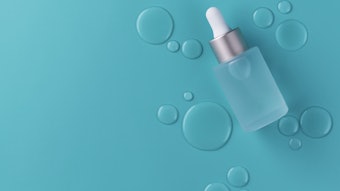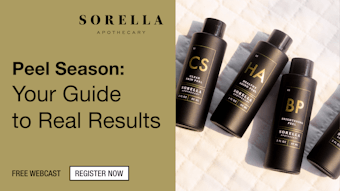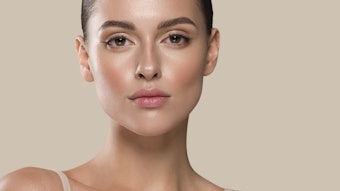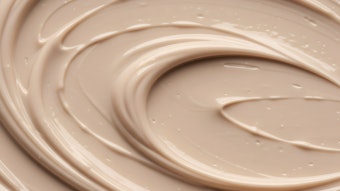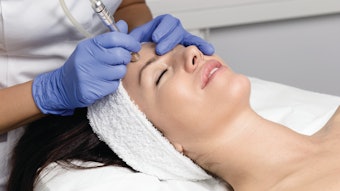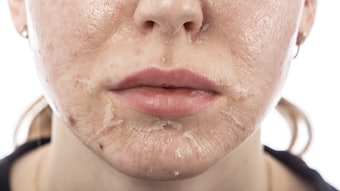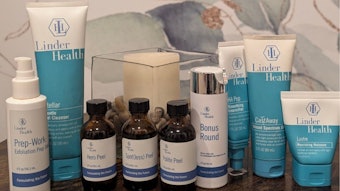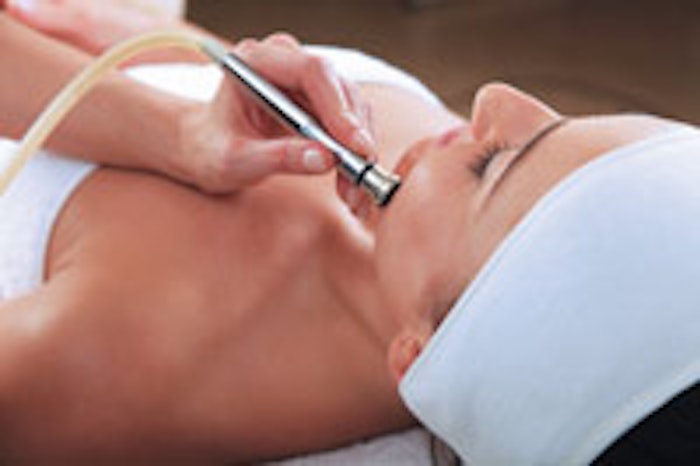
There are a variety of treatments, devices and products available to cosmetic providers for skin rejuvenation. With all of these options, it can be difficult to decipher which will prove effective and which may just be the latest gimmick. Before taking on a new service or product, it is important that you conduct your research. In order to make an educated decision, use reliable sources, including clinical studies and scientific evidence. The key to skin rejuvenation—whether it is mechanical exfoliation, chemical exfoliation, laser, light therapy or microneedling—is to maintain the health of skin structures, stimulate cellular renewal and increase the production of matrix proteins to provide a healthy appearance.
Microdermabrasion
Microdermabrasion is one of the top five nonsurgical procedures performed in a medical setting, with 498,821 treatments performed in 2012 alone, according to the American Society for Aesthetic Plastic Surgery.1 Although this service was originally performed by dermatologists, it is now the most popular exfoliation method used by estheticians. Microdermabrasion refers to mechanically exfoliating the superficial layers of the skin using particles or a rough surface with the use of a tool, while simultaneously creating suction for stimulation. This technology was developed in Italy and gained wide popularity in Europe in the mid-1980s before making its way to the United States in the mid-1990s.
There are currently several methods of microdermabrasion. The original devices were developed using aluminum oxide crystals as the means of exfoliation. Although aluminum oxide works effectively for exfoliation, there has been some controversy regarding the potential hazards of ingesting the material. The use of sodium bicarbonate crystals is becoming the material of choice for crystal microdermabrasion due to its organic nature and smooth texture.
Another development that came about in 1999 is the use of a diamond-tip or particle-free microdermabrasion machine. The diamond-tip provides similar results to the crystal method, but some prefer one over the other. The diamond-tip has a lower cost of consumables and does not leave behind crystals, reducing the risk of side effects, including eye abrasions. On the other hand, there is question about the sanitation methods applied with the reusable diamond tips.
In the past decade, microdermabrasion has continued to evolve, featuring methods such as brush bristles, hydraderm—or wet microderm and dermafiling. There are machines on the market so strong that they can cause pinpoint bleeding with one pass. In contrast, some devices produce such low power that they are similar to using a mild scrub. Regardless of the type of device used, there are other details to consider, such as the strength of the treatment, the vacuum level, the speed of application by the technician, the number of passes performed and the condition of the client’s skin before the treatment.
When to choose microdermabrasion. Microdermabrasion is an effective form of skin rejuvenation for those with a thicker epidermis, hyperkeratotic buildup, superficial pigmented lesions and noninflamed forms of acne (acne grades I and II). It is also a proficient method to use for a boost in exfoliation between other skin-maintenance treatments. Although microdermabrasion undeniably has its place in skin care, it is not always the best choice for all skin types. This technique, like anything else, can be overused or performed in the wrong circumstances. Microdermabrasion should never be used on inflamed conditions of the skin, including rosacea or acne vulgaris (acne grades III and IV). Rosacea, in particular, can worsen through physical means of exfoliation and stimulation. In addition to excess inflammation, capillary walls are often weak in rosacea-sufferers; therefore, utilizing a device that produces suction can cause additional broken capillaries and increased redness. The same could be said for inflamed acne—adding a stimulating component with harsh abrasives could cause increased inflammation, the spread of bacteria and even scarring.
Dermaplaning
Dermaplaning is another form of mechanical exfoliation that has been used for thousands of years. This simple and safe procedure is used for removing dead skin from the epidermis and has the added benefit of removing fine vellus hair, known as “peach fuzz.” When clients hear the word “dermaplaning,” they may associate the term with the procedure dermabrasion. Dermabrasion is a medical procedure in which the skin is often abraded down to the dermis using a whisklike device. Dermaplaning is a light shaving of the epidermis using a scalpel. Although it is ultimately a simple procedure, it is the opinion of many that estheticians should not perform dermaplaning unless under the direction of a medical provider; dermaplaning legalities vary from state to state. Be sure to check with your state before offering dermaplaning services. (Editor’s note: To access a complete list of contact information for each state board, log on to www.SkinInc.com/education/statelicensing.)
When to choose dermaplaning. Dermaplaning is most beneficial for clients with hyperkeratotic buildup, superficial pigmentation, fine lines, uneven texture and vellus hair, and to remove surface skin cells so topical products can penetrate more effectively. It is a good option for clients looking for a surface exfoliation but who are too sensitive for the vacuum associated with microdermabrasion. This treatment can be safely done on mild forms of rosacea, without the presence of papules and pustules, although it has not been shown to directly improve this condition. Dermaplaning is also a viable option for clients who are pregnant or nursing, and looking for a deeper exfoliation without the risk of applying topical products that could potentially be absorbed into the bloodstream. This treatment leaves the skin feeling smooth, which makes it a great option before events.
Microneedling
Microneedling, or collagen induction therapy, is quickly gaining popularity as the go-to treatment for skin rejuvenation. The difference between this treatment and the other methods is that there is no removal of the outer layers of skin. The premise of microneedling is to create a controlled wound response in the skin to stimulate growth factors without abrading the epidermis. Skin-needling was first recognized in 1995 when Norman Orentreich, MD, and David S. Orentreich, MD, used dermal needling as a method to repair scars. Des Fernandes, MD, introduced a stamplike needling device as a method of skin rejuvenation to his patients in 1996. Later, Fernandes designed a dermal roller (a drumlike rolling device with protruding needles) for ease of use.2
Similar to microdermabrasion, there are several factors that can affect the outcome of this procedure. Ensure the device is from a reputable company; and be wary of inexpensive devices seen on the Internet. The latest device to come to market is an automated needling system. This system was developed to provide a more consistent treatment through vertical insertion of needles, reducing the risk of skin tearing commonly associated with the rolling method. The automated needling system also allows for customized depth during treatment, giving the user multiple options for needle length on specific areas of concern. Dependent on the device chosen, there are typically varying needle lengths and gauges, which greatly affect the procedure outcomes. There are some needling devices available for consumers at 0.2 mm, but esthetic devices are typically around 0.5 mm, and medical devices can go as deep as 3 mm, reaching the reticular dermis. Please note that microneedling regulations vary from state to state and it is the responsibility of the technician to ensure they are working within their scope of practice. (Editor’s note: To access a complete list of contact information for each state board, log on to www.SkinInc.com/education/statelicensing.)
When to choose microneedling. Microneedling can be beneficial for all skin types and conditions as long as there is no presence of inflammation; nonetheless, there are still limitations with this treatment. Microneedling is most commonly used for fine lines, wrinkles, acne scarring, pigmentation, stretch marks and even mild forms of noninflamed rosacea. Microneedling at a lower depth is beneficial for rosacea because it does not physically remove the outer layers of skin, but stimulates growth factors to strengthen vessel walls, decreasing inflammation and increasing product penetration. Physicians use this method with longer needles for the treatment of deeper wrinkles and scarring. Treatments can be tailored according to skin types and conditions by altering the device, needle depth and frequency of treatments. The use of topical products may be applied within 10–15 minutes after treatment, while micro-channels are still open, for further customization.
Endless possibilities
The possibilities for skin rejuvenation are endless; from home care products and devices to surgical procedures, and everything in between. Consumers look to skin care professionals as the experts. It is of the utmost importance to gain as much knowledge as possible to help clients form educated decisions about what exfoliation method will best meet their needs.
References
- www.surgery.org/media/news-releases/cosmetic-procedures-increase-in-2012 (Accessed July 8, 2013)
- L Setterfield, The Concise Guide to Dermal Needling, Virtual Beauty Corporation, Whangaparaoa, New Zealand (2010)
As always, Skin Inc. magazine recommends that skin care professionals obtain the proper training before offering any new treatments in their skin care facility.

